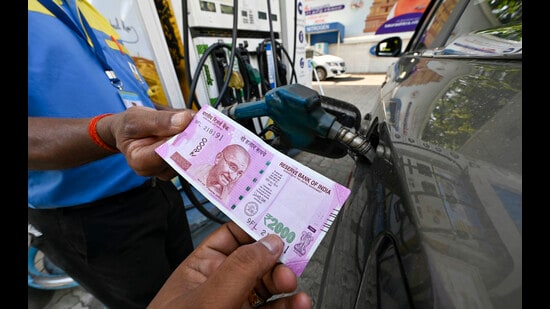Mass cash deposits are likely to come under scanner to catch tax evaders using third party bank accounts to hide their wealth while exchanging ₹2,000 notes, according to officials aware of the development, who said sudden large deposits in multiple Jan Dhan Yojana accounts may also be scrutinised.
Banks have been instructed to report “suspicious” account transactions and tax authorities are planning to use artificial intelligence and data analytics to detect unusual high-value purchases and Jan Dhan Yojana deposits, especially in the coming months when people are expected to get rid of any ₹2,000 currency note before they become invalid at the end of September.
Also Read: Customers line up to exchange ₹2k notes; ‘no change’, say fuel pumps
“While there is no problem for honest people coming to banks to exchange or deposit few ₹2,000 notes, abnormal and unexplained jump in deposits of ₹2,000 notes will certainly raise suspicion. Banks, tax authorities and agencies are on full alert for that,” one of them said.
Jan Dhan Yojana accounts are part of the government’s financial inclusion initiative and most belong to people from poor families.
The second official said the process of exchanging notes for honest people is simple and hassle free. In an internal communication dated May 20, State Bank of India (SBI) said the bank will provide exchange facility for ₹2,000 notes to “all members of the public up to a limit of ₹20,000 at a time” and the same will be allowed “without obtaining any requisition slip”. “Further no identity proof is required to be submitted by the tenderer at the time of exchange,” it added.
Also Read: RBI circular on ₹2000 currency notes withdrawal | Read full text here
Depositing ₹2,000 notes into accounts maintained with any bank can be made in the usual manner, without any restriction, the second official added. “However, deposits would be subject to compliance like know your customer (KYC) norms and other applicable statutory requirements. Banks have been instructed to follow ‘cash transaction reporting’ and ‘suspicious transaction reporting’ as per the norms,” he added.
Any suspicious transaction may invite scrutiny of income-tax department and other agencies, he said. “It is wrong to say that the demonetisation of ₹500 and ₹1,000 notes in November 2016 was futile. In fact, agencies had tracked several suspicious transactions worth crores and actions were initiated against them. Returning of most of the demonetised currencies did not mean that suspicious transactions went unnoticed,” he said.
According to data, almost 99.3% currencies demonetised on November 8, 2016 returned to banks, and there were concerns that Jan Dhan accounts held by the poor played a crucial role in laundering money for unscrupulous rich people.
Also Read: What bankers should know about circulation, deposit, and exchange of ₹2000 notes
Taking cognisance of the matter, the government on November 15, 2016 fixed an upper cash deposit limit of ₹50,000 for each Jan Dhan account.
Experts largely saw two crucial implications of the decision. First, they said, there was unlikely to be any disruption in economic activity, as had been the experience of the 2016 demonetisation exercise, because of several reasons. “One, the notes being withdrawn make up 10.8% of the currency in circulation; whereas in demonetisation, 86% of the currency was impacted. Two, the notes will remain legal tender as opposed to becoming worthless. Three, the notes can be exchanged for lower denominated currency between 23 May to 30 September, which is a larger window for an orderly exchange,” said Pranjul Bhandari, chief India economist at HSBC research, in a note.
Second, is the liquidity implication of the decision. Bhandari said the move could provide some relief temporarily to banking sector liquidity, “but it is not a permanent solution. Eventually, the RBI will have to decide the optimal amount of permanent liquidity it wants to keep in the system, which is in line with its inflation objective, and provide it via the two main sources (dollar and g-sec purchases).”
